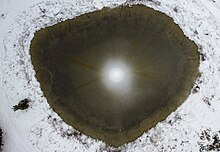Thaw (weather)
This article has multiple issues. Please help improve it or discuss these issues on the talk page. (Learn how and when to remove these messages)
|


Thaw is the period when the snow and ice melt, at the end of the winter, in cold climates.
January thaw
[edit]January thaw is a term applied to a thaw or rise in temperature in mid-winter found in mid-latitude North America.
Sinusoidal estimates of expected temperatures, for northern locales, usually place the lowest temperatures around January 23 and the highest around July 24, and provide fairly accurate estimates of temperature expectations. Actual average temperatures in North America usually significantly differ twice over the course of the year
- Mid-autumn temperatures tend to be warmer than predicted by the sinusoidal model, creating the impression of extended summer warmth known as Indian summer.[1] [citation needed]
- For five days around January 25, temperatures are usually significantly warmer than predicted by the sinusoidal estimate, and also warmer than neighboring temperatures on both sides. [citation needed]
During this "thaw" period, usually lasting for about a week, temperatures are generally about 6 °C (10 °F) above normal.[2] This varies from year to year, and temperatures fluctuate enough that such a rise in late-January temperature would be unremarkable; what is remarkable (and unexplained) is the tendency for such rises to occur more commonly in late January than in mid-January or early February, which sinusoidal estimates have to be slightly warmer.
In some regions (such as northern Canada) this phenomenon will not be manifest as a "thaw" in the technical sense, since temperatures will remain below freezing.
The January thaw is believed to be a weather singularity. A possible physical mechanism for such phenomena was offered in the 1950s by E.G. Bowen: he suggested that some "calendaricities" (as he called them) might be explicable in terms of meteoric particles from cometary orbits acting as ice nuclei in terrestrial clouds;[3][4][5] his theory then received some support from several sources.[6] However, Bowen's ideas later fell out of favour with the development of atmospheric dynamic modelling techniques, although one of his rainfall peaks does seem to correspond with the date of the January thaw.[3][7]
Data analysis has not found statistically significant support for the supposed January thaw.[8] The authors of this study state that "the effects of sampling in finite climate records are wholly adequate to account for the existence of January thaw 'features' in northeastern U.S. temperature data."
See also
[edit]References
[edit]- ^ "NOAA Glossary".
- ^ "What Is A January Thaw?". Farmers’ Almanac. 2010-01-25. Retrieved 2019-01-15.
- ^ a b Bowen, E.G. (1953). "The influence of meteoric dust on rainfall". Australian Journal of Physics. 6 (4): 490–497. Bibcode:1953AuJPh...6..490B. doi:10.1071/ph530490.
- ^ Bowen, E.G. (1956). "The relation between rainfall and meteor showers". Journal of Meteorology. 13 (2): 142–151. Bibcode:1956JAtS...13..142B. doi:10.1175/1520-0469(1956)013<0142:trbram>2.0.co;2.
- ^ Bowen, E.G. (1956). "A relation between meteor showers and the rainfall of November and December". Tellus. 8 (3): 394–402. Bibcode:1956Tell....8..394B. doi:10.1111/j.2153-3490.1956.tb01237.x.
- ^ McNaughton, D.L. (1979). "Meteor Streams and Rainfall". 1980 Yearbook of Astronomy. Sidgwick and Jackson, London: 144–154. ISBN 0-283-98565-8.
- ^ O'Mahoney, G. (1962). "Singularities in daily rainfall". Australian Journal of Physics. 15 (3): 301–326. Bibcode:1962AuJPh..15..301O. doi:10.1071/PH620301.
- ^ Godfrey, C.M., Wilks, D.S., & Schultz, D.M. (2002). "Is the January Thaw a Statistical Phantom?". Bull. Amer. Meteor. Soc. 83 (1): 53–62. Bibcode:2002BAMS...83...53G. doi:10.1175/1520-0477(2002)083<0053:itjtas>2.3.co;2.
{{cite journal}}: CS1 maint: multiple names: authors list (link)
External links
[edit]- "January Thaw: Winter Cold Relief"
- "January Thaw" The Canadian Encyclopedia

